
23 minute read
the system
Progress on the S&N
Coping with the combination of coronavirus related lockdowns and adverse weather conditions for some concreting on the Shrewsbury & Newport
Shrewsbury & Newport Canals
The only work site we at SNCT were able to operate from 5 November to 2 December was our Wappenshall Wharf site. This is because it is classified as a Construction Site and governed by CDM Regulations as well as Covid-19 constraints.
We made considerable progress with the concreting work in the East Basin. We poured the first 28 cubic metres of concrete on the 26 September to form the first 25m of retaining wall base and 7 of the 5m x 2.5m “slabs” for the bottom of the basin. The second 32.5 cubic metre pour was achieved on 14 November, which completed the remainder of the 42m retaining wall base and another 18 basin bottom “slabs.” Working in some atrocious wet and muddy conditions, our team of volunteers have also managed to cast the Preparing for the next 13 base “slabs” to be poured first three sections of Vibrating poker used to get air out of the second concrete wall section the retaining wall. This entailed having to wheelbarrow a lot of concrete about 50m over extremely sticky mud and shovelling it into the formwork. The weather was just too wet to mix it outside! A total length of over 15m of wall has now been cast, so just another 7 wall sections to go now, before we start the brickwork that will go on the top. The concrete section will be Pictures by SNCT below the water line. It’s planned to have the basin ready to rewater by spring 2021.
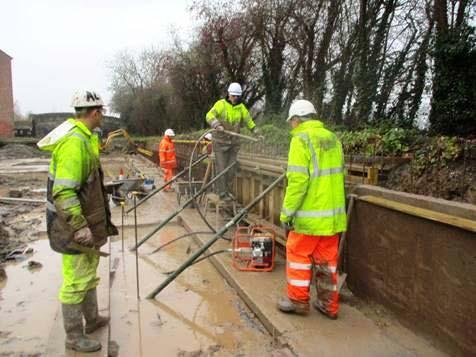
Progress River Gipping
Over in East Anglia, the River Gipping Trust are spending lockdown raising cash for a towpath bridge - and the non-lockdown time tree-planting
Stowmarket Navigation (River Gipping)
River Gipping (Stowmarket Navigation)
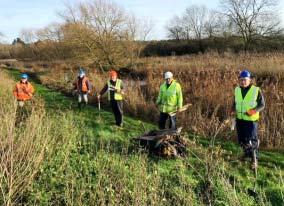
Volunteer work along the river Gipping restarted again in early December following the November lockdown, when all work stopped. River Gipping Trust volunteers planted 200 trees in December along the river where there is little shade from the sun. Work behind the scenes has continued throughout the lockdowns and the Trust have been very successful in obtaining funds from local parish and town councils towards the River Gipping Trust new footbridge over the river Gipping Socially distanced tree planting by the Gipping just above Baylham, which will allow the original towpath route to be restored as years ago, around the time when navigation a permissive path. It had previously been ceased. With the Trust now only a couple of thought that the old footbridge was removed thousand pounds short of being able to around 50 years ago, but a local resident order the kit footbridge ready for volunteers advises that they remember there being no to install, everyone is hopeful of being able bridge in 1941, and that the bridge fell down to erect the bridge this coming summer. or was removed many years earlier, so likely The Trust’s volunteers continue to meet this mile of tow path disappeared nearly 100 up along the river every Wednesday, lockdowns permitting. We have around 20
Stowmarket volunteers, with each work party averaging out at around ten volunteers a time Bosmere Lock (unless restricted byCreeting Lock COVID-19 precau-
Needham Pipps Ford Lock tions). When not
Market Baylham Lock working on the bywash at Pipps Ford Lock and the new bridge, we continue to carry out maintenance work along the towpath between Needham Market and Baylham and beyond. Ipswich New volunteers are always very welcomeLength: 17 miles to come along!Locks: 15 Ian PetcheyOpened: 1793 Restoration managerClosed: 1934 River Gipping Trust page 27
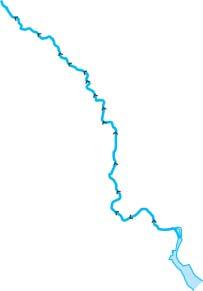
Progress Montgomery
Our plans to support the School House Bridge project with some canal camps have been delayed, but there’s still plenty happening on the Montgomery
Montgomery Canal
rebuild the channel and get the canal open from the current limit of navigation at Gronwen Regular readers will recall that over the past Bridge to Crickheath Wharf) and ‘Crickheath few issues we’ve been including regular South’ (initial work on the next length bereports as the Montgomery Waterway Part- yond Crickheath Wharf, which includes the nership geared up towards the next big site for the new School House Bridge). project to rebuild the demolished School House Bridge. This is the last remaining road Shropshire Union Canal Societyblockage on the English length of the canal, its removal is key to reopening through to Welcome to the final Shropshire Union Canal the Welsh border at Llanymynech, and that Society work party report from a year like no in turn will unlock all sorts of opportunities other. It gives the lowdown on six days of for Welsh funding to get the canal reopened work spread over two consecutive weekends. through to Welshpool and Newtown. And it The big news is that at the end of it all we has been the plan that WRG canal camps had achieved our target of finishing and (along with local volunteering) would be a surcharging the two banks in the subsidence key part of the School House Bridge project, area at the oak tree. There is also substantial which could be kept down to an affordable progress in Crickheath South. Oh, and we cost by using professional contractors just for had a seasonal visitor... the basic structure and volunteers for the rest. The main effort in the channel during
Unfortunately with the continuing gen- the first weekend was finishing the construceral uncertainty relating to the Covid-19 tion of the towpath side bank. As can be situation and in particular the future of the 2021 WRG canal camps programme still subject to discussions and decisions (see elsewhere in this magazine), the timetable for the project is uncertain - so we’ve put the series on hold. But as John Dodwell points out, work hasn’t stopped on the Mont. So here’s an update from the Shropshire Union Canal Society, whose volunteers have been working on two lengths - the ‘Phase 2’ length (the south western end of the current project Pictures by SUCS to waterproof and Vegetation clearance at Crickheath South page 28
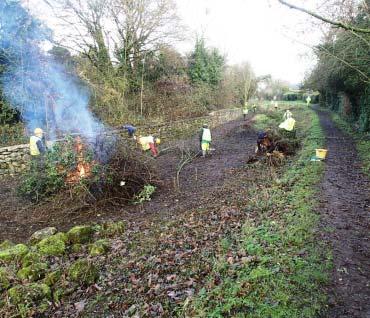
seen from the image this is a massive structure. The ‘hogs back’ shape ensures that the highest point is over the area of maximum predicted subsidence. All being well after the prescribed period of settlement the top of the bank in this area should be near to the level of the rest of the towpath. We will see! To help this process the IBCs [IBC=Intermediate Bulk Container, reusable containers for mass transport and storage of liquids – in this case they were being filled with water The bank pre-loaded with water-filled IBCs for a controlled subsidence to pre-load the area of bank liable to subsidence, to induce a control- of volunteers have subsequently reported led settlement] were placed on top of the having nightmares about this episode. bank. We even had time to start preliminary As with every other facet of life the work on the next section of bank. virus has had a major impact on the restora-
The 136 IBCs were filled during the tion. It is perhaps hard to recall that in the second weekend – the bottom course being early part of the year the more or less confilled completely and those on top half filled. tinuous heavy rain was the thing that made Since each container has a capacity of 1000 life on site hard going. Activities on site were litres this was not a trivial task. Two pumps suspended during the initial lockdown from were used. A hired diesel pump drew water March onwards only for the rain to be replaced from the Phase 1 length of canal and deliv- by a long spell of glorious ‘earthmoving ered it to the tanks, a distance of nearly weather’ which we had no option but to sit 200m. Our little submersible pump was also out. Site activity resumed in late July under pressed into service taking water from the revised working arrangements made possible flooded channel close to the tanks. Ten by the fact that we are Principal Contractors volunteers each day finished the work in a to the Canal & River Trust for the project and day and a half. hence were regarded as ‘working’. It was
The Crickheath South vegetation clear- clear right from the first day of restart that if ance is now finished except for two large we were to have any chance of remaining on trees which will be removed later in the programme we had to complete two of the winter. The brash was disposed of in two four sections of bank that required surcharglarge bonfires. Encouragingly the work ing by the end of the year so as to permit seemed to be well received by the local sufficient time for settlement to take place. residents. The next task in Crickheath South Before we could do this the channel bed had is likely to be somewhat harder – raising the to be treated and drained to permit mafunds to finish the work! chines to run over it: major tasks in them-
During the first weekend we had a visit selves. That both tasks have been completed from the most disreputable looking Santa was made possible by a massive amount of ever to have been allowed out of Lapland. hard work by the volunteers backed up by His patter featured lots of festive cheer but help and advice from CRT, Arcadis and our sadly the promised presents are still stuck many suppliers. Next year promises to be somewhere in the Christmas post. A number equally busy – watch this space!

Progress Wendover
Wendover Arm Trust’s volunteers are battling mud and water, building dog steps, and taking advantage of the lockdown to plan for the future...
Grand Union Wendover Arm
The Wendover Arm Trust’s work party in thDecember 2020 started on Friday 4 and ran ththrough to Monday 14 . We added an extra day (Mon) to allow readymix concreting at the former swing bridge walls adjacent to the new Bridge 4 footbridge. Flood water from previous heavy rain was a problem during the whole work party.
The combination of large amounts of rain two to three months ago, and restricted working due to the Covid-19 virus has meant a large build up of water between Bridge 4 and the car park. This in turn gets churned into a slurry by the plant machines passing through. We hired a different type of pump to our normal ones and this one handled the mixture of slurry and vegetation quite well.
We pumped water and slurry for most of the work party to create a dryish area between the old swingbridge walls. In addition, several earth bunds were created to control the water.
As can be seen later the flooding caused several problems.
Bridge 4 Stop planks: These planks were designed using the standard CRT calculations and they have been made specifically fit the stop plank channels in the Bridge 4 new walls. Further work will be needed to ensure that they fit the channels correctly. Building dog steps and ‘animal access’ points: We have had a constant problem with dogs and other animals getting into the water-filled section of the canal at a mooring wall or similar vertical structure, and then struggling up the next available soil surface to get themselves out. This has caused erosion of the bank down to the Bentomat layer (this is the waterproof liner installed during channel reconstruction to counter the problems of porous ground and severe leakage which caused the canal to be closed). The repairs to the damage in the ‘wet’ section will be done when better weather comes along. In the meantime, we have decided to build these simple block structures at the end of the walls and bridge abutments to alleviate the problem. Additionally, during recent environmental surveys, it was recognised in the restored but dry section that there were several animal tracks that ran down one bank, across the bed, and up the other bank. We have made more ‘animal

All pictures by WAT The new stop planks arriving and (below) working on the swingbridge narrows where they will be used
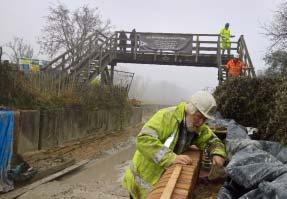
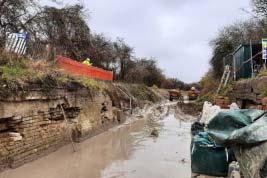
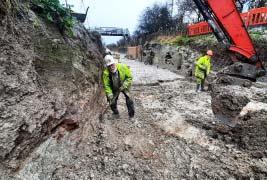

Left, left middle and left bottom: before concreting of the bed between the base of the old swingbridge walls could begin, the area had to be cleared of water and mud. The pictures show it before pumping and clearance started, after much pumping and excavator / hand clearance, and ready for concreting at last Below: the new concrete disappearing under the encroaching water. As explained in the report, WAT is working on methods for better control of water and mud in future

access’ steps at these points.
Concreting at Bridge 4: The task was to cast 300 mm thick reinforced concrete (2 x 4 cubic metres of concrete) between the newly discovered lengths of former swingbridge wall foundations. The excess rainwater and mud had to be pumped out and the bed cleaned up with an excavator and by hand.
All was ready for concreting on Monday th14 morning and the first concrete arrived on schedule at 10:00 at the car park 400 metres away. After a few dumper loads had been delivered it was realised that the mud/ water was breaking through the series of mini bunds along the bed. Towards the end of the concrete pour, the picture shows what it looked like, with the new concrete under water! (Concrete does cure OK under water!) Must try harder next time……
January working party cancelled: sady the January working party was abandoned as a result of Covid precautions, and as we go to press it seems likely that the February and maybe March work parties will suffer the same fate. However, there are page 31

other things happening in the background, in get on and move the tip material (used to fill particular... in the first section of abandoned canal be-
Health & Safety: As seen elsewhere in yond the current limit of navigation at the this report, mud and water have always been Tringford winding hole) off site. The group is a challenge and a driver of potential acci- currently working with CRT and sub-contracdents. The Team Leader group have come up tors to finalise the various agreements and with a potentially better way of shifting the contracts for the first trial phase. A phased water and slurry out of the work area and approach has been taken so that lessons into the restored section beyond Bridge 4 learned from the first excavations and delivback to bridge 4a. We plan to use the centre ery to a remediation works can be incorpoplastic pipes from the Bentomat rolls which rated into the next, larger phase. There are turn out to be 110mm diameter and the around 5,000 tonnes to remove! same as sewer pipe connectors. This will There are other important aspects allow a semi-permanent large diameter drain- being worked on. We need a licence to use age system. the triangle of land next to our existing car
We have also been given permission park. The proposed licence agreement has from the Canal & River Trust to use the pile now reached the Herts County Council legal of old stop planks we have on site as we see team and we await their decision. fit. These will be used to create temporary CRT have applied for pre-planning bunds to control mud and water flow in short permission for the proposed new/modified sections of canal. highway entrance on the HCC triangle and
To make handling and laying of the for moving the hazardous/non-hazardous tip Bentomat easier with less labour and heavy material off site. We now wait to see what lifting, we are currently evaluating a advice the HCC planning people will give us. Bentomat handling excavator attachment Tony Bardwell that will take an uncut roll and place it di- Operations Director rectly along the canal bank. We will find someone who can do stress calculations and ask them to do some calculations for safety and insurance of a lifting tool.
Work has been done on how we set out and fix the concrete pipe capping formwork (used when casting a concrete cap over the cast iron pipe which was laid in the canal bed to carry on the canal’s water supply function after it closed and was drained) to the excavated bed. To save time and effort and greatly reduce the possibility of the form Job done: before and after shots of the restoredwork moving during concreting, the former pumping station site at Whitehousesend design of the form work (150 mm high x 4m long) will be changed to give interlocking sections and a new type of clamp mechanism that holds the formwork at the correct height on the pins inserted in the bed.
Risk assessments and process instructions will be needed before we use this equipment.
Excavating the Historic refuse tip: In another important behind-the-scenes job, a small group has been set up to evaluate the various options we now have to page 32
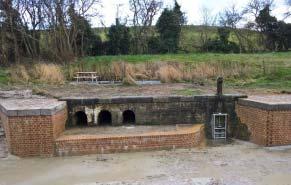
Progress Wooden boats
The Wooden Canal Boat Society is appealing... not for cash for its latest boat restoration, but for volunteers to help the group move forward...
Wooden Canal Boat Society
When you look after wooden boats you are in an Alice-like world of running very fast to stand still. Worse than that, if you let the rot get ahead of you it grows exponentially. Wooden boats need continuity of maintenance. If you are looking after, for example, a steam locomotive, you can park it in a siding for 20 years or more. When you return, yes it will be rusty, but most of it will still be there. Do that with a wooden boat and you’ll return to find a pile of mush.
Does it matter? Well, yes, if you care about the waterways heritage it does. Wooden boats have been pretty much unchanged since the dawn of the canal age. They are a link to the working past of the waterways. Just as important as keeping the boats is keeping the skills of boatbuilding. There are so few extant and afloat that it’s important to protect and maintain the survivors. The WCBS collection includes the last surviving Runcorn ‘wooden header’ narrow boat and the oldest surviving wooden motor narrow boat.
Beside the heritage aspect, the WCBS is committed to making use of the boats for projects that promote wellbeing for our planet and its people. Hazel is a wellbeing boat, providing time on the waterways for people who have been struggling with mental health issues. The recycling trips, combined with the charity shop, save a huge amount of material from being wasted in polluting landfill. They also provide regular free boating opportunities for anyone who would like to help out. Unfortunately, Covid has caused the suspension of recycling trips.
The next challenge is not just doing another boat restoration but building an organisation that is strong and stable (hmmm, unfortunate choice of words perhaps) enough to keep them maintained and active into what is likely to be an increasingly difficult future.
The WCBS has survived the pandemic with help from Government business support measures.
As, hopefully, restrictions ease through 2021, the society has to get into a phase of growth. For this it needs people. Capable, intelligent, helpful and supportive people. The boat fleet is of national importance. Up to now the WCBS has relied mainly on volunteers from the Greater Manchester area but, with video conferencing a necessity at present, it’s become possible to some extent to include people remotely for some roles.
Volunteers that the society is currently looking for include :-
.Retail business development person, to seek out opportunities to expand the outlets for donated re-usable goods. . Fundraiser, to seek grants for boat restoration and other projects. . Administrator, to keep the bureaucracy on the straight and narrow. . Chronicler, a person who can turn up whenever the volunteers are busy with something to take pictures and write about it for circulation in print and electronic media. . Volunteer co-ordinator, to make sure the right volunteers turn up at the right place at the right time, as well as finding new volunteers. . Lots of people to raise funds by selling stuff online (not necessary to be local)
Some of these roles could turn into paid jobs, depending on the success of the first two. Anyone who would like to help should email general@wcbs.org.uk
WCBS

Progress Lichfield Canal
An update on work on the south side of Lichfield, involving a new channel, restoration of an existing length, and squeezing through a pinch point...
Lichfield Canal
Lichfield and Hatherton Canals Restoration Trust volunteers have concentrated their efforts on two sections during the autumn. Adhering to Covid-19 restrictions, separate work parties have made great progress at Fosseway Heath and Gallows Reach.
At Fosseway Heath volunteers have continued to create a long section of a new channel, where the route for the restored canal diverges from the original line (which has been obstructed) and runs alongside Falkland Road, part of the Lichfield Southern Bypass. A towpath is being created on the Falkland Road side of the canal, sitting on a massive bank created by building two lines of breeze blocks infilled with concrete and clay reinforcing a mound of concrete-filled sandbags, topped with turf.
On the opposite side of the channel, sheet steel piling backed with tons of earth allows the construction of another towpath, which in time will provide a circular walk incorporating the Fosseway Heath Nature Reserve and Wetlands. Further progress along Falkland Road is dependent on impending permissions and agreements.
At Gallows Reach, next to Tamworth Road, a small team has been extending the restored length of towpath wall and added a further 160 metres to the Heritage Towpath Trail.
In between these two worksites, the route of the Lichfield Canal between London Road and Birmingham Road has been safe-
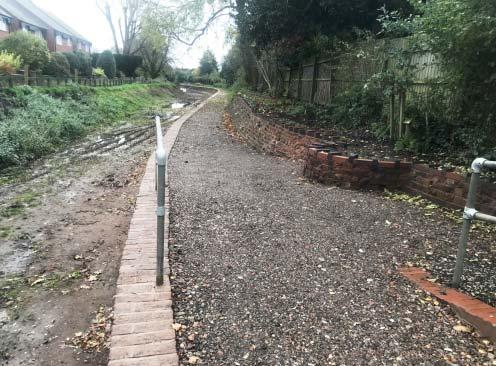
LHCRT
guarded by a unique agreement involving LHCRT, County, District and City Councils and housing developer Persimmon Homes. The canal route runs through a ‘pinch point’ created by a 450-home housing development at St John’s Grange and the extension of the Lichfield Southern Bypass. After painstaking negotiations, agreement was reached to fit the canal and Heritage Lock 23 into the overall design. Two bridges are being built over the canal to carry link roads between the new estate and the bypass.

See back cover for another picture of the Lichfield Canal work
Lichfield Canal
Length: 7 miles Locks: 30 Date closed: 1955
Diversions to be built to avoic obstructions to restoration A38 LICHFIELD
To Fradley Coventry Canal
Huddlesford
To Coventry
To Anglesey Basin Ogley M6Toll Junction BypassA461
A5
Fosseway Heath work site Wyrley & Essington Canal to Wolverhampton A51
Next part of bypass to be built Tamworth Road Locks
HS2? Gallows Reach work site
Heritage Lock 23 ‘pinch point’
New channel being built alongside Falkland Road section of bypass The Lichfield Canal is the name given by canal restorers to the abandoned eastern six miles or so of the Wyrley & Essington Canal. The canal originally stretched from the Birmingham Canal Navigations Main Line in Wolverhampton to a junction with the Coventry Canal at Huddlesford, but this eastern length which included all 30 of the canal’s locks was closed in the 1950s to save the cost of maintaining the locks. With the remaining length (and much of the northern part of the BCN system) still navigable but very quiet, reopening the abandoned length is seen as a key to getting more boats onto these underused waterways, while also connecting the historic city of Lichfield.

Progress Wey & Arun Canal
As with many sites, practical work has been paused on the W&A, but planning is going ahead for the reinstatement of a missing road crossing...
Wey & Arun Canal
Solution to road crossing headache: A tricky road blockage standing in the way of the canal restoration and a problematic single-lane road causing traffic problem in the Surrey village of Cranleigh could both be dealt with simultaneously, if the Wey & Arun Canal Trust’s proposal is granted planning permission.
The Trust has submitted an application to Waverley Borough Council to widen the single-lane Elmbridge Road that runs from Cranleigh to the A281, to create a two-way road and footway. The road widening would include a replacement canal bridge, allowing restoration of the Wey & Arun Canal beneath the major obstacle that the current road represents.
Surrey County Council had identified Elmbridge Road as a priority project, setting aside Section 106 funding (developer contributions) from new housing, and these funds will be used for the road widening, while WACT will fund footpath improvements and restoration of the canal itself. The project also includes some “enabling development” on the existing residential plot that will be severed when the canal is reinstated.
The proposal includes the restoration of 330m of the canal south of Elmbridge Road. The level of the canal will be lowered by about 2 metres to pass through the new bridge without excessive raising of the road. This will in turn require a new lock (eventually forming the northern limit of the restored canal’s summit level) to be built, towards the southern end of the restored length, and the line of the towpath will be adjusted to cross the canal twice, once via the new bridge and again via a footbridge at the lock.
The project involves extensive improvements to existing footpaths with widening and resurfacing, and the creation of a new dedicated route for the residents of the nearby retirement village to reach Cranleigh’s centre.
Responses to a public consultation held in October 2019 were overwhelmingly positive, with respondents believing the plans to be an enhancement of the current road situation and enhancement to public access to the canal and countryside.
Keeping up the hours: Despite the limitations of lockdown, the Wey & Arun Canal Trust’s volunteers clocked up an impressive 21,807 hours of work in 2020, just 5,614 down on the previous year.
Working parties were stood down during the spring lockdown and again at the end of the year (and are still suspended as we go to press), and the Trust also missed the visiting working party weekends and canal camps it benefited from in 2019 when three week-long camps were held, along with numerous weekend visits.
When regular working parties were able to resume, teams were kept to small groups to manage the restrictions, but several working parties increased the number of days they operated. The EWG group, which usually operates on a Thursday, began working across five days a week with reduced numbers to make up for lost time on the Harsfold Bridge project at Wisborough Green. Despite winter storms, flooding and the pandemic hampering construction, the team managed to complete the project on time in the late summer as a result.
Volunteers were also able to work across several days at the latest major project, the Tickner’s Heath road crossing at Alfold, Surrey.
Operating during the pandemic also created extra hours for the directors and back office volunteers, as they worked on how to operate the Canal Centre, boat trips and working parties safely. Their efforts meant the Canal Centre operated and boat cruises were able to run from August through to the end of December, bringing in much needed funds.
If you would like to volunteer in any way, please email support@weyandarun.co.uk to express your interest.







